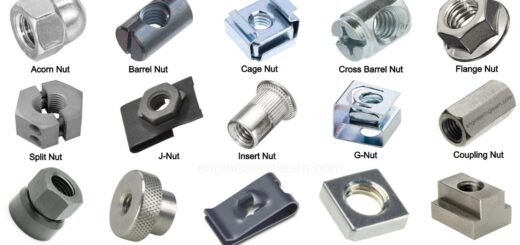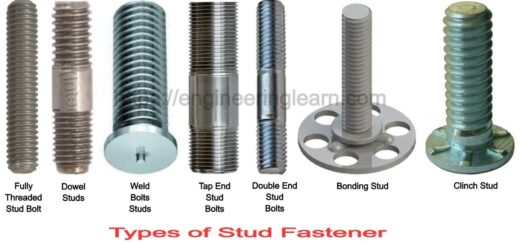5 Types of Knobs (Mechanical) – Uses, Benefits & Drawbacks [Complete Details]
![5 Types of Knobs (Mechanical) - Uses, Benefits & Drawbacks [Complete Details]](https://engineeringlearn.com/wp-content/uploads/2023/01/Knob-1024x539.jpg)
What are Knobs?
5 Types of Knobs (Mechanical) – Uses, Benefits & Drawbacks [Complete Details]: – A mechanical knob is a device that allows for manual adjustment of various settings on machines and other devices. Common examples include volume knobs on stereos and setting knobs on ovens. While they are now largely replaced by digital controls, mechanical knobs still have a few advantages. For one, they are often more durable than their electronic counterparts. They also tend to be easy to use, even for people unfamiliar with the particular device they are adjusting. Finally, in some cases, mechanical knobs can provide a more precise control than electronic controls.
What are Knobs Used for?
Mechanical knobs are most commonly used on devices that require frequent adjustments, such as ovens and stereos. They are also sometimes used on more small, frequently adjusted appliances, such as washing machines and dryers. In general, mechanical knobs are best suited for devices that require relatively simple adjustments (such as changing the volume or temperature) rather than more complex ones (such as programming a computer).
There are three main types of mechanical knobs: knob handles, T-handles, and lever handles. Knob handles are the simplest type of knob; they consist of a round body with a protrusion on the top or side that can be turned with the fingers. T-handles have a T-shaped body with a grip at one end and a turning mechanism at the other; they can be turned with either the fingers or a wrench. Lever handles have a long body with a grip at one end and a turning mechanism at the other; they must be turned with a twist.
How do Mechanical Knobs Work?
There are two main types of mechanical knobs: those with a set screw and those without. Set screws are usually found on higher-end models, and they work by holding the knob on the pot’s shaft or switch. This ensures that the knob doesn’t lose over time and fall off. Knobs without set screws rely on friction to stay in place, so they can be more easily removed if needed.
To remove a knob with a set screw, you’ll need to use a small Allen wrench to loosen the screw. Once it’s reduced, you should be able to pull the knob straight off the shaft. If your knob is held on by friction, you should be able to grip it firmly and twist it counter clockwise until it comes free.
Once you have the old knob off, look at how it was attached to see what type of replacement knob you’ll need. If there’s a threaded insert in the shaft, you’ll need another knob with a set screw; if not, any friction-fit knob will do. When installing your new knob, ensure the set screw is tight, so it doesn’t come loose over time!
5 Types of Knobs
Many mechanical knobs are available on the market, but some are more popular than others. Here is a detailed explanation of the five most popular types of mechanical knobs:
1. Push-pull Knob: ( Types of Knobs )
A push-pull mechanical knob is a type of knob that can be pushed in or pulled out. It is commonly used on doors and drawers but can also be found on other types of furniture. Push-pull knobs are easy to use and offer various benefits over traditional knobs.
One benefit of push-pull knobs is that they can be used with one hand. This is especially helpful if you have your hands complete or if you’re trying to open a door while carrying something. Traditional knobs require two hands to operate, which can be inconvenient.
Another advantage of push-pull knobs is that they’re less likely to get damaged. Because you don’t have to twist or turn them, there’s no risk of damage from putting too much pressure on the knob. Traditional knobs are more delicate and can easily be broken if not handled carefully.
Finally, push-pull knobs offer a more modern look than traditional ones. If you’re looking for a way to update the appearance of your furniture, switching to push-pull knobs is an easy and effective way to do it.
2. Prong Knob: ( Types of Knobs )
The Prong Mechanical Knob is a simple yet elegant solution to your everyday needs. With its unique design, the Prong Mechanical Knob is perfect for both function and style. The Prong Mechanical Knob is made of high-quality materials and construction, making it durable and long-lasting. With its sleek design, the Prong Mechanical Knob will complement any décor. The Prong Mechanical Knob is easy to install and use, making it a great addition to your home.
3. Ball Knob: ( Types of Knobs )
This particular style of knob is designed for use with ball-type levers, such as those found on many faucets and valves. The knob comprises a hollow sphere with a threaded hole in the centre. A setscrew or other type of fastener secures the lever to the knob.
The popularity of the mechanical ball knob stems from its simple design and ease of use. The spheres can be made from various materials, including brass, plastic, and steel. They are also available in a wide range of sizes, making them suitable for applications where space is limited.
One advantage of the mechanical ball knob is that it can be easily removed and reinstalled if necessary. This allows for quick and easy repairs or replacements if needed. Additionally, the spherical shape of the knob makes it easier to grip than other types of knobs.
4. Knurled Rim Knob: ( Types of Knobs )
This industrial-style knob is perfect for adding a touch of grunge to any décor. The knurled rim provides a textured grip that is both comfortable and stylish. The mechanical design gives this knob a unique look that will stand out in any setting.
This knob is perfect for anyone who wants to add grunge to their décor. The knurled rim provides a textured grip that is both comfortable and stylish. The mechanical design gives this knob a unique look that will stand out in any setting.
This knob is the perfect way to add a bit of edge to your décor. The knurled rim provides a textured grip that is both comfortable and stylish. The mechanical design of this knob makes it stand out from the rest, adding a unique touch to any setting.
If you’re looking for a way to add some personality to your home décor, this knurled rim mechanical knob is perfect! The textured grip and unique design make this knob stand out in any setting.
5. T-handle Knob: ( Types of Knobs )
A T-Handle Mechanical Knob is a type of knob that is used to operate a machine or other device. It is usually attached to a shaft or lever and can be turned to adjust the device’s speed, direction, or tension. The knob consists of a handle that is vulcanized onto a circular base. The word “T-Handle” comes from the handle shaped like the letter T. There are many types of T-Handle Mechanical Knobs available on the market, each designed for specific applications.
One popular type of T-Handle Mechanical Knob is the Ball Knob. This knob has a spherical head that can be turned in any direction. The ball knob was initially designed for lathes but can also be used on other machinery such as drills Machines and milling machines. Another common type of T-Handle Mechanical Knob is the Mushroom Head Knob. This knob has a round head with a flat top, which gives it a mushroom-like appearance. Mushroom head knobs are often used in applications where space is limited, such as in control panels or switchboards.
T-Handle Mechanical Knobs are an essential part of many machines and devices. They are easy to operate and provide good grip and traction when turning. When choosing a T-Handle Mechanical Knob for your application, selecting one made from high-quality materials and construction is essential to last long and perform well under duress conditions encountered during operation periods.
Benefits of Using Knobs
There are many benefits of using mechanical knobs over traditional push buttons:
- They provide a much more tactile way of interacting with your devices. This means that you can quickly tell if you are pushing the button in the right spot, allowing for finer input control.
- They are often more durable than push buttons since there is no exposed mechanism to break.
- They can give your devices a unique look and feel that sets them apart from the competition.
Some might say that digital displays are the way of the future, but there are still plenty of reasons to stick with reliable old mechanical knobs. For one thing, they provide a more physical and intuitive way to interact with your devices. It can be easy to tell if you’re pushing the button in the right spot and have more control over inputs. They’re often more durable since there’s no exposed mechanism for breaking. Plus, they can give your devices a unique look and feel that sets them apart from the competition.
Drawbacks to Using Knobs
The main drawback to using mechanical knobs is that they can be challenging to control. This is especially true if you are trying to manage multiple parameters simultaneously. Mechanical knobs can also be less precise than other types of controls, such as digital controls. Finally, mechanical knobs can wear out over time and may need to be replaced periodically.
Another potential drawback of mechanical knobs is that they can be challenging to clean. If you are using them in a kitchen or other food preparation area, crumbs and other debris can quickly accumulate on the surface of the knob. This can make it challenging to keep the site sanitary.
Mechanical knobs can also be noisy. They may click or squeak as you turn them, which can be distracting or even annoying. This may not be ideal if you are trying to work in a quiet environment.
Finally, depending on the materials they are made from, mechanical knobs may not be very durable. Over time, they may crack, chip, or break if they are subject to too much wear and tear.
Conclusion
Mechanical knobs offer many advantages over traditional push buttons, including a more tactile input, increased durability, and a unique look and feel. However, they can be challenging to control, less precise than other types of controls, and may need to be replaced periodically. Mechanical knobs can also be challenging to clean and noisy when in use.
Content Source: – monroeengineering













